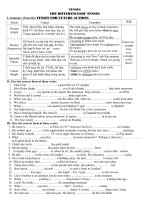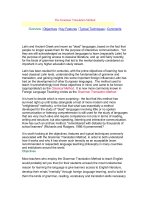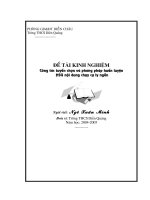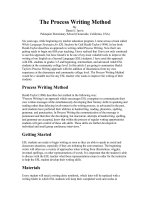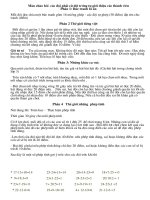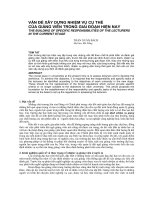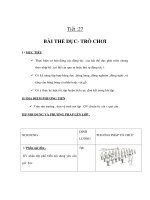The Grammar Translation Method.doc
Bạn đang xem bản rút gọn của tài liệu. Xem và tải ngay bản đầy đủ của tài liệu tại đây (84.23 KB, 7 trang )
The Grammar Translation Method
Overview | Objectives | Key Features | Typical Techniques | Comments
Latin and Ancient Greek are known as "dead" languages, based on the fact that
people no longer speak them for the purpose of interactive communication. Yet
they are still acknowledged as important languages to learn (especially Latin) for
the purpose of gaining access to classical literature, and up until fairly recently,
for the kinds of grammar training that led to the mental dexterity considered so
important in any higher education study stream.
Latin has been studied for centuries, with the prime objectives of learning how to
read classical Latin texts, understanding the fundamentals of grammar and
translation, and gaining insights into some important foreign influences Latin has
had on the development of other European languages. The method used to
teach it overwhelmingly bore those objectives in mind, and came to be known
(appropriately!) as the Classical Method. It is now more commonly known in
Foreign Language Teaching circles as the Grammar Translation Method.
It is hard to decide which is more surprising - the fact that this method has
survived right up until today (alongside a host of more modern and more
"enlightened" methods), or the fact that what was essentially a method
developed for the study of "dead" languages involving little or no spoken
communication or listening comprehension is still used for the study of languages
that are very much alive and require competence not only in terms of reading,
writing and structure, but also speaking, listening and interactive communication.
How has such an archaic method, "remembered with distaste by thousands of
school learners" (Richards and Rodgers, 1986:4) perservered?
It is worth looking at the objectives, features and typical techniques commonly
associated with the Grammar Translation Method, in order to both understand
how it works and why it has shown such tenacity as an acceptable (even
recommended or respected) language teaching philosophy in many countries
and institutions around the world.
Objectives
Most teachers who employ the Grammar Translation Method to teach English
would probably tell you that (for their students at least) the most fundamental
reason for learning the language is give learners access to English literature,
develop their minds "mentally" through foreign language learning, and to build in
them the kinds of grammar, reading, vocabulary and translation skills necessary
to pass any one of a variety of mandatory written tests required at High School or
Tertiary level.
Some teachers who use the method might also tell you that it is the most
effective way to prepare students for "global communication" by beginning with
the key skills of reading and grammar. Others may even say it is the "least
stressful" for students because almost all the teaching occurs in L1 and students
are rarely called upon to speak the language in any communicative fashion.
More conservative teachers from more conservative countries are even likely to
be put out by anyone merely questioning the method, and a typical response
could be "because that's the way it's always been done - it's the way I learned
and look, now I'm a professor". The point being, the method is institutionalized
and considered fundamental. Such teachers are probably even unware that the
method has a name and can be compared alongside other methods.
Top | Objectives | Key Features | Typical Techniques | Comments
Key Features
According to Prator and Celce-Murcia (1979:3), the key features of the Grammar
Translation Method are as follows:
(1) Classes are taught in the mother tongue, with little active use of the target
language.
(2) Much vocabulary is taught in the form of lists of isolated words.
(3) Long elaborate explanations of the intricacies of grammar are given.
(4) Grammar provides the rules for putting words together, and instruction often
focuses on the form
and inflection of words.
(5) Reading of difficult classical texts is begun early.
(6) Little attention is paid to the content of texts, which are treated as exercises
in in grammatical
analysis.
(7) Often the only drills are exercises in translating disconnected sentences from
the target language
into the mother tongue.
(8) Little or no attention is given to pronunciation.
Top | Objectives | Key Features | Typical Techniques | Comments
Typical Techniques
Diane Larsen-Freeman, in her book Techniques and Principles in Language
Teaching (1986:13) provides expanded descriptions of some common/typical
techniques closely associated with the Grammar Translation Method. The listing
here is in summary form only.
(1) Translation of a Literary Passage
(Translating target language to native language)
(2) Reading Comprehension Questions
(Finding information in a passage, making inferences and relating to personal
experience)
(3) Antonyms/Synonyms
(Finding antonyms and synonyms for words or sets of words).
(4) Cognates
(Learning spelling/sound patterns that correspond between L1 and the target
language)
(5) Deductive Application of Rule
(Understanding grammar rules and their exceptions, then applying them to
new examples)
(6) Fill-in-the-blanks
(Filling in gaps in sentences with new words or items of a particular grammar
type).
(7) Memorization
(Memorizing vocabulary lists, grammatical rules and grammatical paradigms)
(8) Use Words in Sentences
(Students create sentences to illustrate they know the meaning and use of
new words)
(9) Composition
(Students write about a topic using the target language)
Top | Objectives | Key Features | Typical Techniques | Comments
Comments
Many people who have undertaken foreign language learning at high schools or
universities even in the past 10 years or so may remember many of the teaching
techniques listed above for the Grammar Translation Method. They may also
recall that the language learning experience was uninspiring, rather boring, or
even left them with a sense of frustration when they traveled to countries where
the language was used only to find they couldn't understand what people were
saying and struggled mightily to express themselves at the most basic level.
Very few modern language teaching experts would be quick to say that this is an
effective language teaching method, and fewer would dare to try and assert that
it results in any kind of communicative competence. As Richards and Rodgers
(1986:5) state, "It is a method for which there is no theory. There is no literature
that offers a rationale or justification for it that attempts to relate it to issues in
linguistics, psychology, or educational theory."
And yet the Grammar Translation Method is still common in many countries -
even popular. Brown attempts to explain why the method is still employed by
pointing out
"It requires few specialized skills on the part of teachers. Tests of grammar rules
and of translations are easy to construct and can be objectively scored. Many
standardized tests of foreign languages still do not attempt to tap into
communicative abilities, so students have little motivation to go beyond grammar
analogies, translations, and rote exercises." (1994:53)
